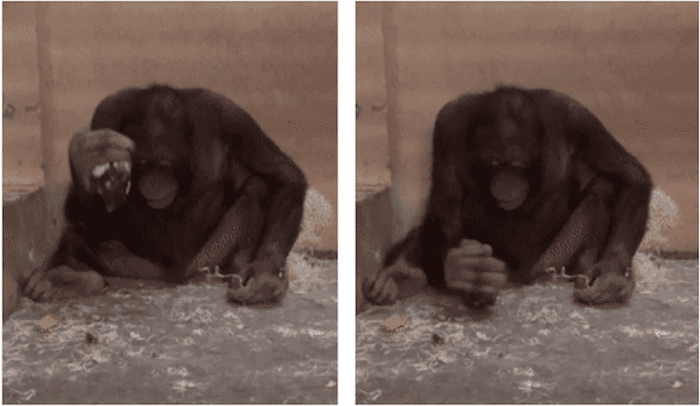
Orangutans are a crafty bunch. They seem to be able to use a bunch of tools in the wild and even make complex choices about these tools. So a team of researchers led by Alba Motes-Rodrigo at the University of Tübingen in Germany wanted to test their stone tool-making ability. The researchers tested out their hypothesis on two orangutans at Kristiansand Zoo in Norway.
“We wanted to investigate what stone-related behaviors might have served as stepping stones for the development of lithic technologies in our lineage. Extant apes (and monkeys) can be used as living models to build hypotheses in this regard,” Motes-Rodrigo tells ZME Science.
“We decided to test orangutans because despite being proficient tool users and using a variety of raw materials as tools, they do not use stone tools in the wild. This absence of stone tool use behaviors in the wild orangutan repertoire supports the naivety of our study subjects before the start of the experiments. This naivety allowed us to investigate the learning process of stone-related skills from the beginning, excluding previous knowledge of the tasks.”
Each orangutan was provided with a concrete hammer, a specially prepared blunt stone core, and two baited puzzle boxes. In order to get through the boxes, the orangutans had to cut through a rope or a silicon skin — but if they could do it, they got a treat.
Initially, both orangutans started hitting the hammer against the walls and floor of their enclosure. They didn’t strike the stone core directly. In the second experiment, they were also given a human-made sharp flint flake, which one orangutan used to cut the silicon skin, solving the puzzle.
It’s the first time cutting behavior has been observed in untrained, unenculturated orangutans. In a subsequent experiment, researchers demonstrated how to strike the core to create a flint to three female orangutans at another zoo (Twycross Zoo) in the UK. After being taught, one female went on to use the hammer to hit the core as demonstrated.
This suggests that two major prerequisites for creating stone tools (striking with stone hammers and recognizing that sharp edges can cut) may have existed in our common lineage with orangutans 13 million years ago. However, this is merely speculation at this point and we need more evidence before we can truly say whether this was the case or not.
“Our results have added a new piece to the puzzle of the technological origins of our species showing that an ape species that does not use stone tools in the wild and that diverged from our lineage 13 million years ago, spontaneously engages in stone-related behaviours crucial for stone tool making (lithic percussion) as well as has the ability to recognise and use sharp stones as cutting tools.”
“The lithic percussive behaviours that we observed seem to be relatively common among primates, with species such as macaques, capuchins and chimpanzees also expressing them in the wild and in some studies in captivity. The use of a sharp stone as a cutting tool had never been reported before in an untrained ape, but given that we only have one observation of this behaviour it would be premature to draw strong conclusions about its evolutionary history.”

The orangutans’ tool-making is remarkable, but they haven’t entered the Stone Age just yet, Motes-Rodrigo tells ZME Science. Essentially, their tools are not complex enough, and we haven’t seen them do this in a natural environment. They could be capable of doing it, but we haven’t observed them doing it. So, for the moment we can’t place them in the Stone Age just yet.
“Even the most primitive human stone tools were far more advanced than what we have seen in orangutans and reflect advanced spatial and cognitive skills. In addition, these behaviors have only been observed in captivity under experimental conditions. Perhaps if in future we would make similar observations in the wild, we could make such claims, but at the moment we can’t.”
Journal Reference: Motes-Rodrigo A, McPherron SP, Archer W, Hernandez-Aguilar RA, Tennie C (2022) Experimental investigation of orangutans’ lithic percussive and sharp stone tool behaviours. PLoS ONE 17(2): e0263343. https://doi.org/10.1371/journal.pone.0263343


